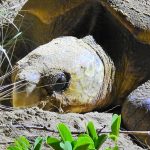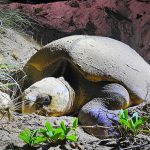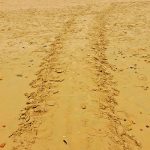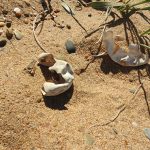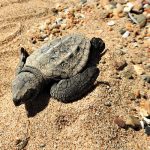LOGGERHEAD TURTLE
Encountering the Giant of Australian Coasts
Imagine walking along a quiet, moonlit beach in Queensland. The only sound is the gentle rustling of waves. Suddenly, a shape emerges from the sea—an ancient Loggerhead sea turtle, her large, expressive eyes reflecting starlight. As she hauls herself across the cool sand, each movement carries the weight of generations before her. This is just the beginning of a remarkable cycle—one that connects life on land with the vast, blue mystery of the oceans.
Distinctive Features That Set the Loggerhead Apart
- Large, Powerful Head: The loggerhead’s most distinguishing feature is its sizable head, built for strength.
- Reddish-Brown Carapace: Its shell glows with sun-warmed hues, patterned like rippling water under sunlight.
- Impressive Size: Adults grow up to 1 metre in length and can weigh between 80 to 160 kilograms.
Multi-Sensory Portrait
- Visual: Rust-red shell gleaming as seawater evaporates.
- Auditory: The soft hiss as she shuffles through powdery sand.
- Olfactory: The crisp, clean scent of ocean breeze mingling with the earthy aroma of the beach at night.
Life Along Australian Shores
Loggerhead turtles prefer Australia’s warm, subtropical waters. They’re seen:
- Along the eastern and western coastlines
- Often near the Great Barrier Reef and sandy Queensland beaches
Their natal homing brings them back to the very shores where their journey began, to nest and continue the cycle.
The Mighty Hunter of the Reef
Loggerhead turtles are carnivorous, both patient and purposeful as they forage:
- Prey: Jellyfish, crustaceans like crabs, molluscs, and occasionally fish.
- Adaptation: Their robust jaws can crush hard shells, letting them access a rich array of ocean life.
By hunting along sea floors, loggerheads help keep marine ecosystems in balance, showing that each bite shapes the health of their underwater home.
Life Cycle: From Hatchling to Ocean Explorer
The Nesting Ritual
- Breeding season: October to March in Australia
- Nesting behaviour: Females come ashore at night, digging deep, careful nests for their eggs.
- Eggs per season: Up to 120 per clutch, several clutches per season.
The Perilous Journey
Newly-hatched turtles wriggle from their sandy nest, guided by the shimmer of moonlight on the waves. Their dash to the water is urgent—each tiny turtle’s journey is fraught with danger, yet some will survive to return, decades later, to the same beach.
Navigation Masters
Loggerhead turtles possess an extraordinary ability to navigate:
- Migration: Thousands of kilometres across oceans, guided by Earth’s magnetic field.
- Lifespan: Often exceeding 50 years, testament to their endurance and adaptability.
Challenges and Conservation
Threats
| Challenge | Description |
|---|---|
| Habitat Loss | Beach development reduces safe nesting sites |
| Pollution | Plastics and chemicals endanger turtles and their food sources |
| Bycatch | Accidental capture in fishing gear can be fatal |
| Climate Change | Rising temperatures affect hatchling sex and health |
Conservation in Action
Efforts in Australia and worldwide include:
- Protecting nesting grounds
- Minimising bycatch through changes to fishing equipment
- Marine pollution reduction
- Community education about the importance of marine conservation
Emotional Connection: Guardianship of the Future
Standing by the ocean, watching a loggerhead turtle return to the sea evokes awe and a sense of responsibility. Their survival depends on our actions as much as on their own endurance.
By protecting the loggerhead turtle, we preserve a living bridge between the ancient and modern worlds, ensuring these gentle giants will continue to inspire those who walk Australia’s beaches for generations to come. Each conservation effort is a step towards repairing the delicate balance of our marine ecosystems—so these remarkable creatures may always find their way home.
Let’s carry the story of the loggerhead turtle with us—a reminder that the natural world’s marvellous dramas are worth cherishing and protecting.
- Want to help loggerhead turtles? Seek out local beach clean-up days or support marine conservation organisations.

